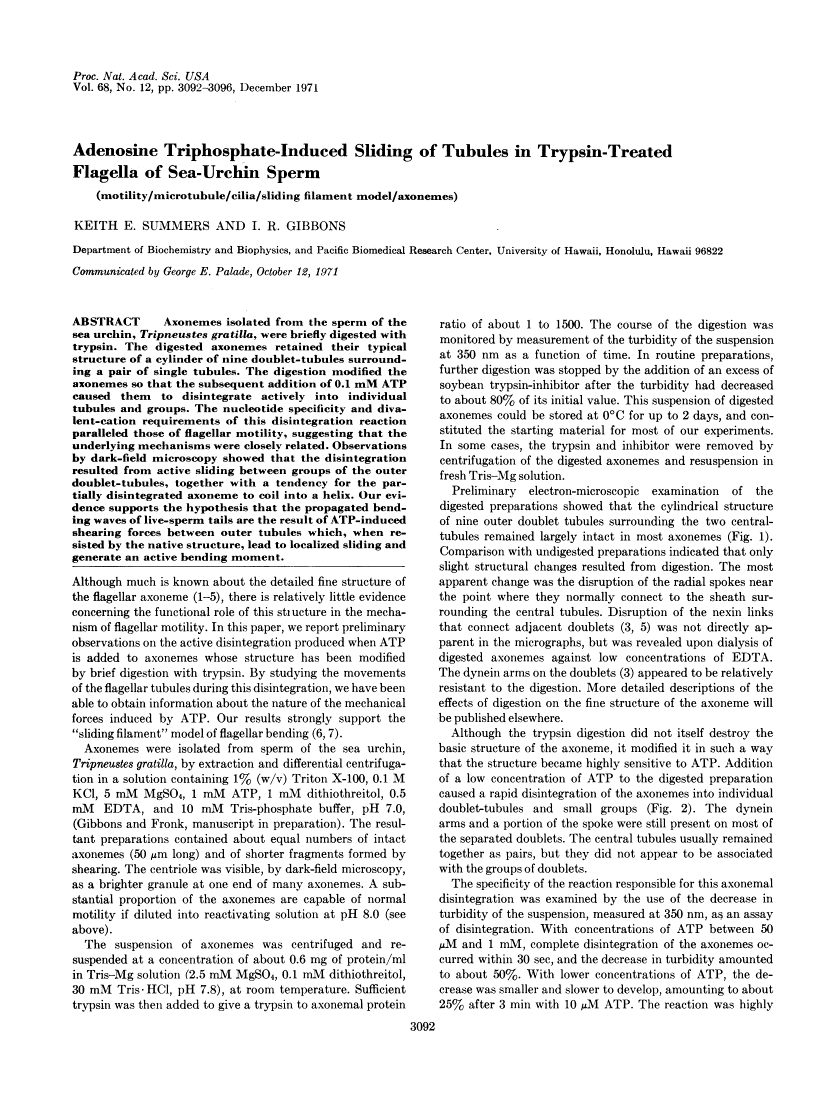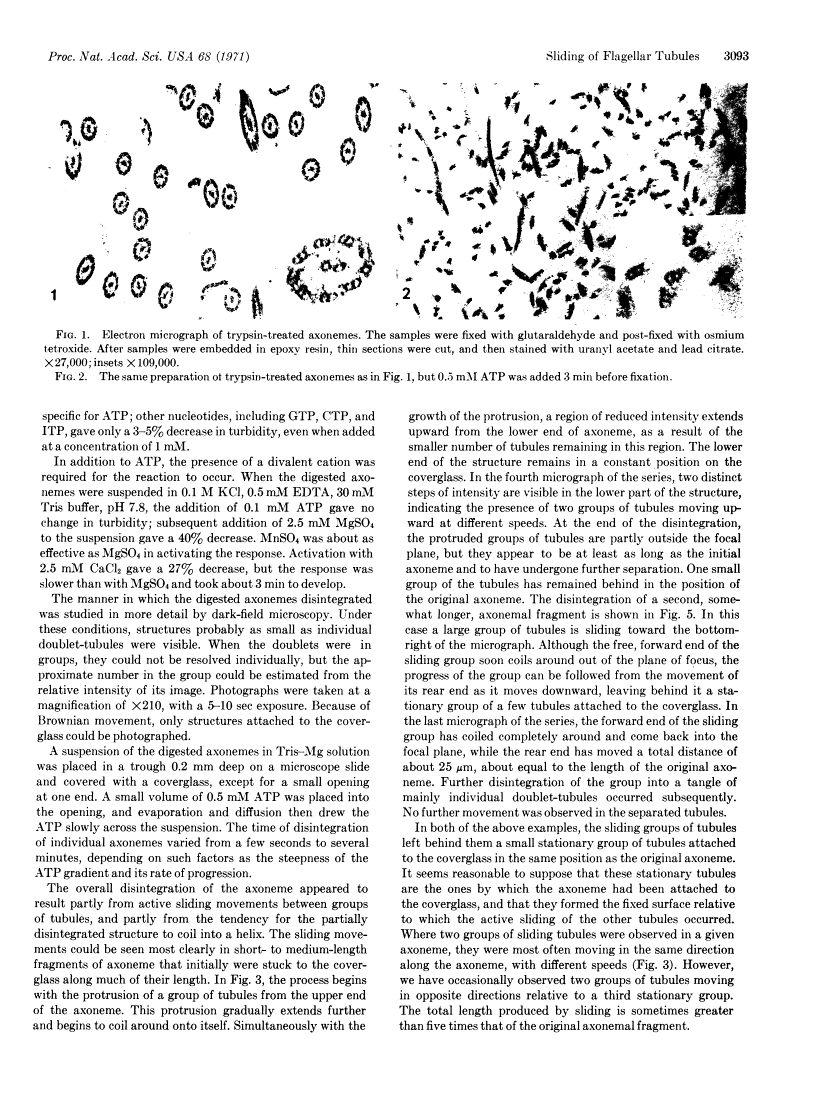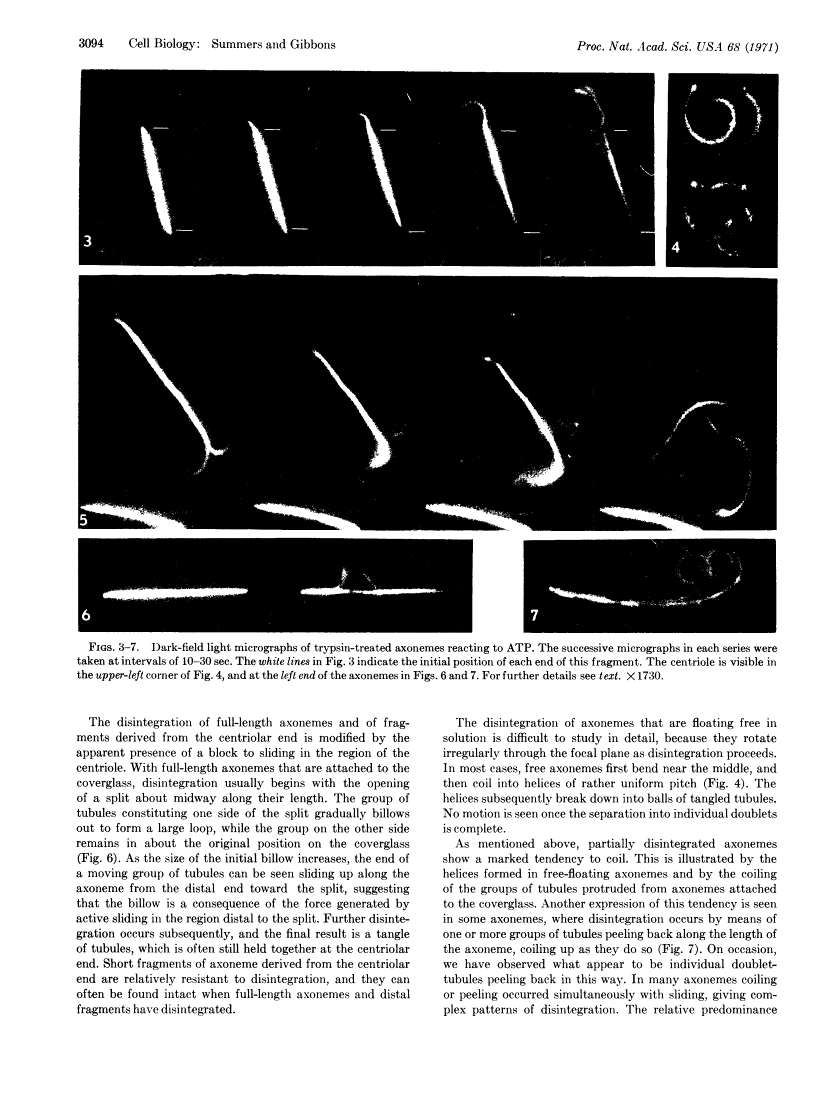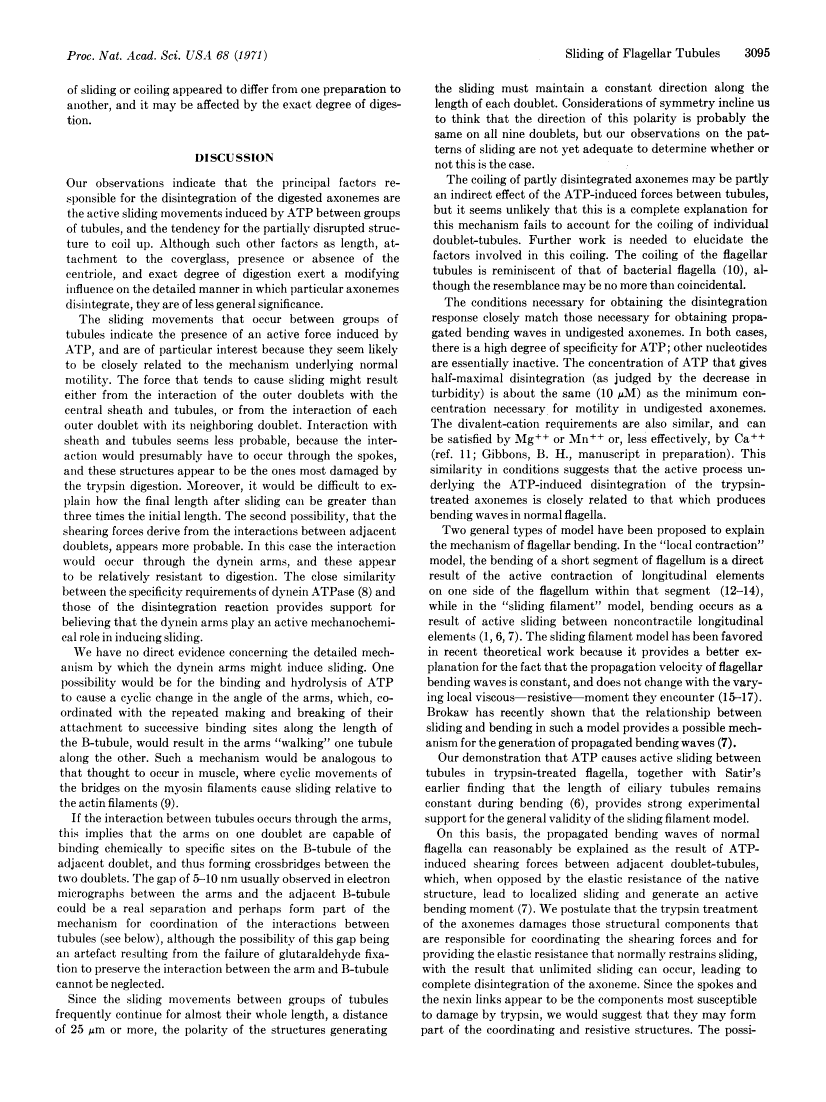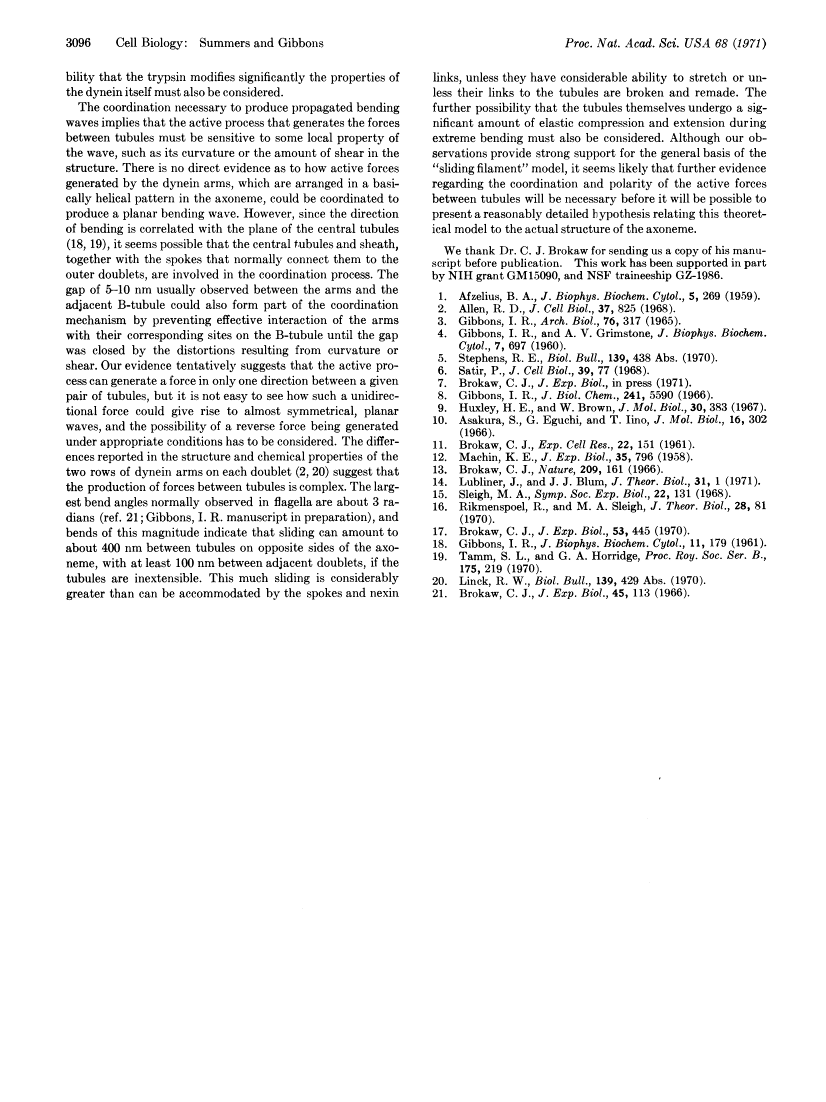Abstract
Free full text

Adenosine Triphosphate-Induced Sliding of Tubules in Trypsin-Treated Flagella of Sea-Urchin Sperm
Abstract
Axonemes isolated from the sperm of the sea urchin, Tripneustes gratilla, were briefly digested with trypsin. The digested axonemes retained their typical structure of a cylinder of nine doublet-tubules surrounding a pair of single tubules. The digestion modified the axonemes so that the subsequent addition of 0.1 mM ATP caused them to disintegrate actively into individual tubules and groups. The nucleotide specificity and divalent-cation requirements of this disintegration reaction paralleled those of flagellar motility, suggesting that the underlying mechanisms were closely related. Observations by dark-field microscopy showed that the disintegration resulted from active sliding between groups of the outer doublet-tubules, together with a tendency for the partially disintegrated axoneme to coil into a helix. Our evidence supports the hypothesis that the propagated bending waves of live-sperm tails are the result of ATP-induced shearing forces between outer tubules which, when resisted by the native structure, lead to localized sliding and generate an active bending moment.
Full text
Full text is available as a scanned copy of the original print version. Get a printable copy (PDF file) of the complete article (1.7M), or click on a page image below to browse page by page. Links to PubMed are also available for Selected References.
Images in this article
Selected References
These references are in PubMed. This may not be the complete list of references from this article.
- AFZELIUS B. Electron microscopy of the sperm tail; results obtained with a new fixative. J Biophys Biochem Cytol. 1959 Mar 25;5(2):269–278. [Europe PMC free article] [Abstract] [Google Scholar]
- Gibbons IR. Chemical dissection of cilia. Arch Biol (Liege) 1965;76(2):317–352. [Abstract] [Google Scholar]
- GIBBONS IR, GRIMSTONE AV. On flagellar structure in certain flagellates. J Biophys Biochem Cytol. 1960 Jul;7:697–716. [Europe PMC free article] [Abstract] [Google Scholar]
- Satir P. Studies on cilia. 3. Further studies on the cilium tip and a "sliding filament" model of ciliary motility. J Cell Biol. 1968 Oct;39(1):77–94. [Europe PMC free article] [Abstract] [Google Scholar]
- Gibbons IR. Studies on the adenosine triphosphatase activity of 14 S and 30 S dynein from cilia of Tetrahymena. J Biol Chem. 1966 Dec 10;241(23):5590–5596. [Abstract] [Google Scholar]
- Huxley HE, Brown W. The low-angle x-ray diagram of vertebrate striated muscle and its behaviour during contraction and rigor. J Mol Biol. 1967 Dec 14;30(2):383–434. [Abstract] [Google Scholar]
- Asakura S, Eguchi G, Iino T. Salmonella flagella: in vitro reconstruction and over-all shapes of flagellar filaments. J Mol Biol. 1966 Apr;16(2):302–316. [Abstract] [Google Scholar]
- Brokaw CJ. Bend propagation along flagella. Nature. 1966 Jan 8;209(5019):161–163. [Abstract] [Google Scholar]
- Lubliner J, Blum JJ. Model for bend propagation in flagella. J Theor Biol. 1971 Apr;31(1):1–24. [Abstract] [Google Scholar]
- Sleigh MA. Patterns of ciliary beating. Symp Soc Exp Biol. 1968;22:131–150. [Abstract] [Google Scholar]
- Rikmenspoel R, Sleigh MA. Bending moments and elastic constants in cilia. J Theor Biol. 1970 Jul;28(1):81–100. [Abstract] [Google Scholar]
- Brokaw CJ. Bending moments in free-swimming flagella. J Exp Biol. 1970 Oct;53(2):445–464. [Abstract] [Google Scholar]
- GIBBONS IR. The relationship between the fine structure and direction of beat in gill cilia of a lamellibranch mollusc. J Biophys Biochem Cytol. 1961 Oct;11:179–205. [Europe PMC free article] [Abstract] [Google Scholar]
- Brokaw CJ. Effects of increased viscosity on the movements of some invertebrate spermatozoa. J Exp Biol. 1966 Aug;45(1):113–139. [Abstract] [Google Scholar]
Associated Data
Articles from Proceedings of the National Academy of Sciences of the United States of America are provided here courtesy of National Academy of Sciences
Full text links
Read article at publisher's site: https://doi.org/10.1073/pnas.68.12.3092
Read article for free, from open access legal sources, via Unpaywall:
https://europepmc.org/articles/pmc389597?pdf=render
Citations & impact
Impact metrics
Article citations
Structural determination and modeling of ciliary microtubules.
Acta Crystallogr D Struct Biol, 80(pt 4):220-231, 07 Mar 2024
Cited by: 0 articles | PMID: 38451206 | PMCID: PMC10994176
Review Free full text in Europe PMC
CEP104/FAP256 and associated cap complex maintain stability of the ciliary tip.
J Cell Biol, 222(11):e202301129, 26 Sep 2023
Cited by: 5 articles | PMID: 37756660 | PMCID: PMC10522465
Integrated modeling of the Nexin-dynein regulatory complex reveals its regulatory mechanism.
Nat Commun, 14(1):5741, 15 Sep 2023
Cited by: 10 articles | PMID: 37714832 | PMCID: PMC10504270
Versatile properties of dynein molecules underlying regulation in flagellar oscillation.
Sci Rep, 13(1):10514, 29 Jun 2023
Cited by: 0 articles | PMID: 37386019 | PMCID: PMC10310797
Motility Assessment of Ram Spermatozoa.
Biology (Basel), 11(12):1715, 26 Nov 2022
Cited by: 6 articles | PMID: 36552225 | PMCID: PMC9774426
Review Free full text in Europe PMC
Go to all (331) article citations
Other citations
Similar Articles
To arrive at the top five similar articles we use a word-weighted algorithm to compare words from the Title and Abstract of each citation.
Effects of trypsin digestion on flagellar structures and their relationship to motility.
J Cell Biol, 58(3):618-629, 01 Sep 1973
Cited by: 82 articles | PMID: 4747919 | PMCID: PMC2109072
Study of the mechanism of vanadate inhibition of the dynein cross-bridge cycle in sea urchin sperm flagella.
J Cell Biol, 82(1):291-298, 01 Jul 1979
Cited by: 45 articles | PMID: 158028 | PMCID: PMC2110420
Sliding velocity between outer doublet microtubules of sea-urchin sperm axonemes.
J Cell Sci, 44:169-186, 01 Aug 1980
Cited by: 27 articles | PMID: 6449515
Microtubule sliding in reactivated flagella.
Symp Soc Exp Biol, 35:159-177, 01 Jan 1982
Cited by: 14 articles | PMID: 6764040
Review
